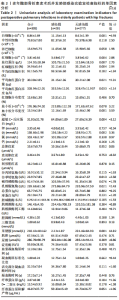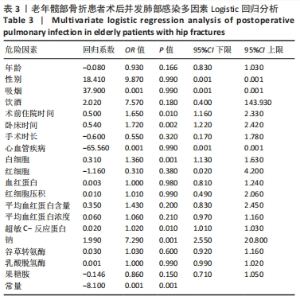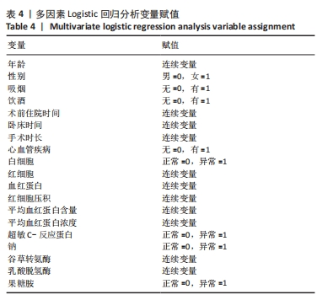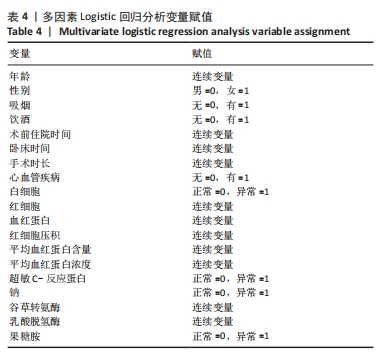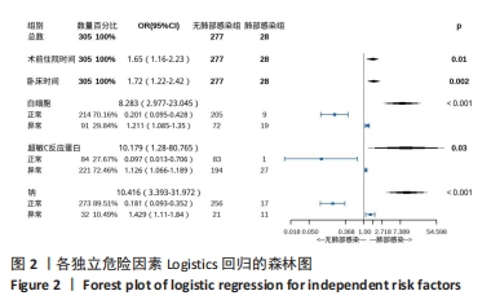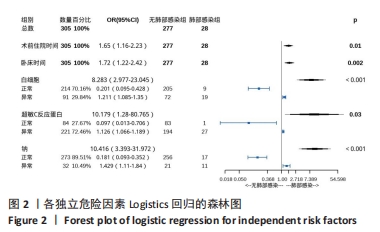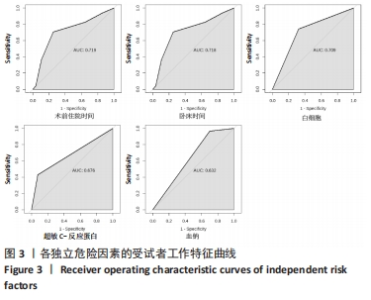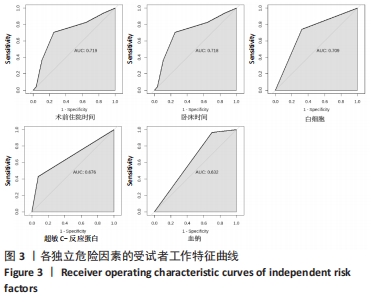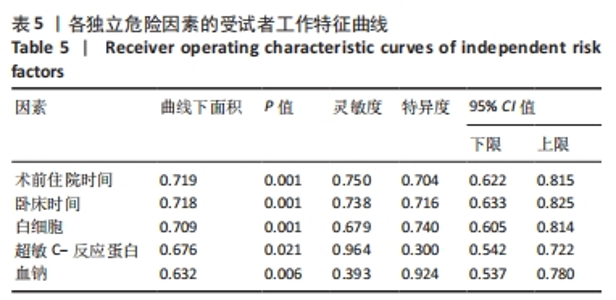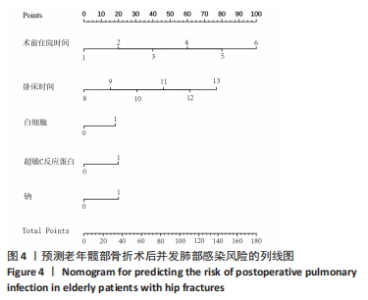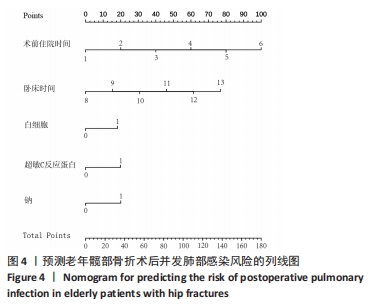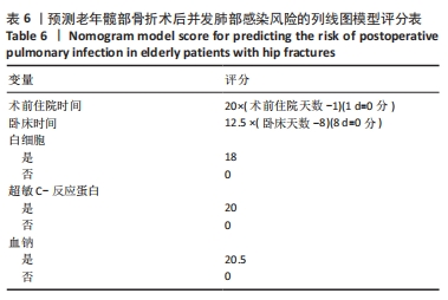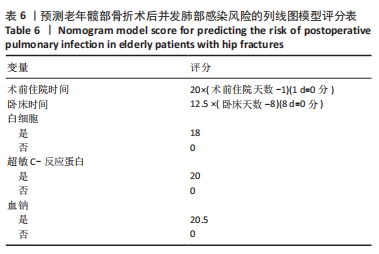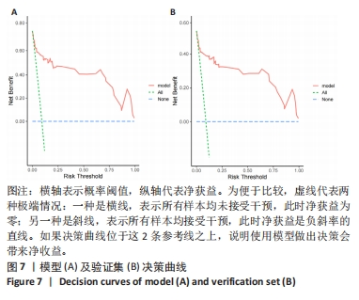Chinese Journal of Tissue Engineering Research ›› 2024, Vol. 28 ›› Issue (36): 5785-5792.doi: 10.12307/2024.681
Previous Articles Next Articles
Postoperative pulmonary infection in elderly patients with hip fracture: construction of a nomogram model for influencing factors and risk prediction
Wang Haotian1, Wu Mao1, 2, Yang Junfeng2, Shao Yang2, Li Shaoshuo2, Yin Heng1, 2, Yu Hao2, Wang Guopeng1, Tang Zhi1, Zhou Chengwei1, Wang Jianwei1, 2
- 1Nanjing University of Chinese Medicine, Nanjing 210023, Jiangsu Province, China; 2Wuxi Traditional Chinese Medicine Hospital Affiliated to Nanjing University of Chinese Medicine, Wuxi 214071, Jiangsu Province, China
-
Received:2023-09-13Accepted:2023-11-17Online:2024-12-28Published:2024-02-27 -
Contact:Wang Jianwei, MD, Chief physician, Nanjing University of Chinese Medicine, Nanjing 210023, Jiangsu Province, China; Wuxi Traditional Chinese Medicine Hospital Affiliated to Nanjing University of Chinese Medicine, Wuxi 214071, Jiangsu Province, China -
About author:Wang Haotian, Master candidate, Nanjing University of Chinese Medicine, Nanjing 210023, Jiangsu Province, China -
Supported by:National Natural Science Foundation of China, No. 82174400 (to WM); The “Double Hundred” Top Talent Project, No. BJ2020066 (to YJF); Jiangsu Traditional Chinese Medicine Science and Technology Development Plan Project, No. YB2020042 (to SY); Medical and Health Guidance Project of Wuxi Municipal Bureau of Science and Technology, No. SKJJZD19 (to SY); Scientific Research Project of Wuxi Municipal Health and Health Commission, No. Q201945 (to SY)
CLC Number:
Cite this article
Wang Haotian, Wu Mao, Yang Junfeng, Shao Yang, Li Shaoshuo, Yin Heng, Yu Hao, Wang Guopeng, Tang Zhi, Zhou Chengwei, Wang Jianwei. Postoperative pulmonary infection in elderly patients with hip fracture: construction of a nomogram model for influencing factors and risk prediction[J]. Chinese Journal of Tissue Engineering Research, 2024, 28(36): 5785-5792.
share this article
Add to citation manager EndNote|Reference Manager|ProCite|BibTeX|RefWorks
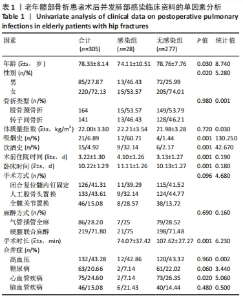
2.3 术后肺部感染的单因素分析 纳入训练集的305 例患者中,术后肺部无感染组277例(占90.82%),肺部感染组28例(感染率9.18%)。对两组患者临床资料的单因素分析结果见表1,两组实验室检查指标的单因素分析结果见表2。结果显示,两组患者的年龄、性别、受伤至手术时间、卧床时间、手术时长、吸烟史、饮酒史、术前是否存在心血管疾病、白细胞、红细胞、血红蛋白、红细胞压积、平均血红蛋白含量、平均血红蛋白浓度、血小板分布宽度、超敏C-反应蛋白(hypersensitive C-reactive protein,Hs-CRP)、钠、谷草转氨酶、乳酸脱氢酶、果糖胺水平比较差异有显著性意义(P < 0.05);两组在手术方式、麻醉方式、骨折类型、体质量指数、高血压、糖尿病、脑血管疾病等基础疾病以及其他血化验检查结果方面比较,差异无显著性意义(P > 0.05)。"

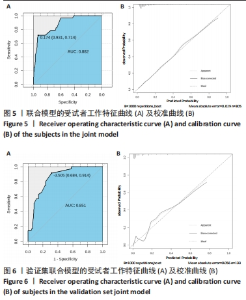
2.8 老年髋部骨折患者术后肺部感染列线图模型的验证 训练集中联合模型AUC为 0.882(95%CI值为0.819-0.944),截断值(cut off)值为 (0.931,0.714),见图5A,均有统计学意义(P < 0.05)。C-index是综合模型区分能力和一致性的指标,R统计得出C-index为0.88,C-index与AUC一致,该模型区分度良好,具有较高的诊断预测价值。运用R语言绘制出的列线图模型校准曲线,大致位于斜率为1的标准曲线与可接受线之间,贴合度较好,则说明该列线图预测髋部骨折老年患者术后并发肺部感染的风险与实际发生风险一致性良好,模型预测能力良好(图5B)。验证集AUC值为0.851(图6A),列线图C-index及训练集、验证集AUC值均> 0.70,表明模型预测准确度较高。同时,以Bootstrap(B=1 000)进行重复抽样以检验预后模型的校准度,校准曲线显示该列线图预测患者肺部感染与临床实际肺部感染相比有良好的一致性,表明该模型的拟合度较好(图6B)。"
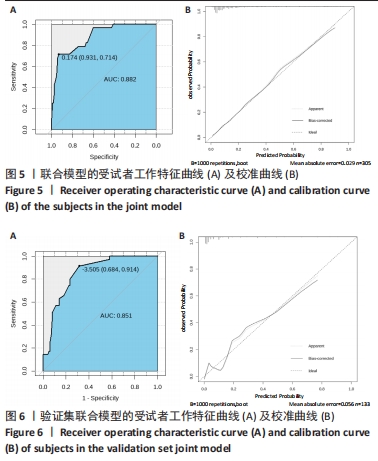
| [1] SHIN KH, KIM JJ, SON SW, et al. Early Postoperative hypoalbuminaemia as a risk factor for postoperative pneumonia following hip fracture surgery. Clin Interv Aging. 2020;15:1907-1915. [2] 张玉. 老年髋部骨折术后肺部感染风险模型的研究[D].合肥:安徽医科大学,2023. [3] 张欣. 老年髋部骨折患者术后谵妄与肺炎风险预测中列线图的建立与验证[D].上海:中国人民解放军海军军医大学,2023. [4] SUMAN VJ, ATKINSON EJ, O’FALLON WM, et al. A nomogram for predicting lifetime hip fracture risk from radius bone mineral density and age. Bone. 1993;14(6):843-846. [5] FU M, ZHANG Y, ZHAO Y, et al. Characteristics of preoperative atrial fibrillation in geriatric patients with hip fracture and construction of a clinical prediction model: a retrospective cohort study. BMC Geriatr. 2023;23(1):310. [6] JIANG J, XING F, LUO R, et al. Risk factors and prediction model of nomogram for preoperative calf muscle vein thrombosis in geriatric hip fracture patients. Front Med (Lausanne). 2023;10:1236451. [7] HAN S, BAI Y, JIAO K, et al. Development and validation of a newly developed nomogram for predicting the risk of deep vein thrombosis after surgery for lower limb fractures in elderly patients. Front Surg. 2023;10:1095505. [8] 雷英,刘艳丽,李阳,等.髋部骨折并发下肢深静脉血栓形成危险因素分析[J].中华创伤杂志,2019,35(9):817-822. [9] 中华医学会呼吸病学分会感染学组.中国成人医院获得性肺炎与呼吸机相关性肺炎诊断和治疗指南(2018年版) [J].中华结核和呼吸杂志,2018,41(4):255-280. [10] 周方伦,王利宏,单军标,等.合并肺栓塞髋部骨折患者手术与非手术治疗的疗效比较[J].中华创伤杂志,2019,35(10):907-912. [11] 李金奇,崔北辰,王军强,等.老年髋部骨折患者术后2年内再发对侧髋部骨折的危险因素研究[J].中华创伤骨科杂志,2021, 23(3):209-215. [12] 韩超,李晓丹,孙翔,等.老年髋部骨折快速手术的研究进展[J].中国修复重建外科杂志,2023,37(12):1556-1561. [13] 刘泽民,吕欣,刘晋元,等.髋部骨折2342例流行病学分布特点的单中心分析[J].中国组织工程研究,2020,24(32):5085-5091. [14] SHEEHAN KJ, WILLIAMSON L, ALEXANDER J, et al. Prognostic factors of functional outcome after hip fracture surgery: a systematic review. Age Ageing. 2018;47(5):661-670. [15] CHANG W, LV H, FENG C, et al. Preventable risk factors of mortality after hip fracture surgery: Systematic review and meta-analysis. Int J Surg. 2018;52:320-328. [16] 岳睿,李晓玉,杨明辉,等.老年髋部骨折患者围手术期输血和危险因素[J].首都医科大学学报,2021,42(4):629-634. [17] 应璞,诸磊,许岳,等.老年股骨粗隆间骨折术后1年内死亡分析[J].中国矫形外科杂志,2022,30(4):294-298. [18] TIAN Y, ZHU Y, ZHANG K, et al. Incidence and risk factors for postoperative pneumonia following surgically treated hip fracture in geriatric patients: a retrospective cohort study. J Orthop Surg Res. 2022;24;17(1):179. [19] 罗颢文,涂江龙,刘建模,等.特征选择技术在江西地区缺血性脑卒中合并肺部感染风险预测模型中的应用[J].现代预防医学,2020, 47(22):4038-4041+4052. [20] 姜源涛,姜源波.老年髋部骨折患者围手术期肺部感染危险因素分析[J].中华医院感染学杂志,2013,23(21):5185-5187. [21] HE P, FAN SY, GUAN JQ, et al. Mediation analysis for the relationship between dyslipidemia and coronary artery disease via hypersensitive C-reactive protein in a case-control study. Coron Artery Dis. 2020; 31(7):613-619. [22] LIU Y, HUANG X, LIU Y, et al. Application value of hypersensitive C-reactive protein, lactic acid and myoglobin in the combined detection of myocarditis. Exp Ther Med. 2019;17(6):4471-4476. [23] 白植琴,钱彩华,陆华东,等.重症肺部感染患者血清感染学指标和免疫学指标对预后的预测价值[J].中华医院感染学杂志,2022, 32(20):3052-3056. [24] LO RH, KALANTAR-ZADEH K, YOU AS, et al. Dysnatremia and risk of bloodstream infection in dialysis patients. Clin Kidney J. 2022;15(12): 2322-2330. [25] CASTELLO LM, GAVELLI F, BALDRIGHI M, et al. Hypernatremia and moderate-to-severe hyponatremia are independent predictors of mortality in septic patients at emergency department presentation: A sub-group analysis of the need-speed trial. Eur J Intern Med. 2021; 83:21-27. [26] LEUNG AA, MCALISTER FA, FINLAYSON SR, et al. Preoperative hypernatremia predicts increased perioperative morbidity and mortality. Am J Med. 2013;126(10):877-86. [27] 吕璟,蒋泽磊,陈薛连,等.高血压脑出血患者肺部感染的危险因素及TLR4/NF-κB通路水平[J].中华医院感染学杂志,2023,33(20): 3057-3060. [28] 李婷,裴永菊,王文慧,等.基于Logistic回归模型分析影响高血压脑出血患者术后肺部感染的危险因素[J].实用中西医结合临床, 2023,23(11):56-59. [29] 任一欣,吴娜,房美,等.老年高血压合并冠心病患者PCI术后合并肺部感染的危险因素[J].中国老年学杂志,2023,43(6):1290-1292. [30] SINGH JA, HOUSTON TK, PONCE BA, et al. Smoking as a risk factor for short-term outcomes following primary total hip and total knee replacement in veterans. Arthritis Care Res. 2011;63(10): 1365-1374. [31] 刘星星,贺清明.老年髋部骨折病人肺部感染危险因素的Meta分析[J].护理研究,2021,35(2):195-205. [32] 白静,巴楠,张小娟,等.胃癌根治术后肺部感染病原菌及危险因素[J].中华医院感染学杂志,2020,30(21): 3316-3320. [33] XIAO H, ZHOU H, LIU K, et al. Development and validation of a prognostic nomogram for predicting post-operative pulmonary infection in gastric cancer patients following radical gastrectomy. Sci Rep. 2019;9(1):14587. [34] BOHL DD, SERSHON RA, SALTZMAN BM, et al. Incidence, risk factors, and clinical implications of pneumonia after surgery for geriatric hip fracture. J Arthroplasty. 2018;33(5):1552-1556. [35] 张玉,孙炜,孙维超,等.入院红细胞体积分布宽度与老年髋部骨折术后肺部感染的关系及其预测价值[J].天津医药,2022,50(6): 608-612. [36] 尹鹏滨,吕厚辰,张里程,等.髋部骨折患者住院期间新发肺部感染的危险因素分析[J].中华创伤骨科杂志,2015,17(9):745-750. [37] 张丽琴,杨雅瑾,刘庆军,等.老年髋部骨折患者术后肺部感染的危险因素分析[J].中国骨与关节损伤杂志,2022,37(4):395-397. [38] 孙春生,郑欣,郭开今,等.入院时低基础代谢率与老年髋部骨折患者死亡率的关系[J].中国组织工程研究,2018,22(16):2467-2471. [39] 李莉,陈念,柯柳,等.老年髋部骨折围术期肺部感染危险因素分析[J].中国组织工程研究,2014,18(35):5736-5740. |
| [1] | Xi Jintao, Lu Qilin, Wang Yang, Wang Xiaojuan, Lyu Peng, Chen Long, Shi Zhen, Xie Wei, Zhu Yiliang, Li Xugui. Risk factors for cage retropulsion following transforaminal lumbar interbody fusion [J]. Chinese Journal of Tissue Engineering Research, 2024, 28(9): 1394-1398. |
| [2] | Yang Cekai, Cai Zhuoyan, Chen Ming, Liu Hao, Weng Rui, Cui Jianchao, Zhang Shuncong, Yao Zhensong. Relationship between degeneration of paraspinal muscle and refractures in postmenopausal women treated by percutaneous vertebroplasty [J]. Chinese Journal of Tissue Engineering Research, 2024, 28(9): 1414-1419. |
| [3] | Han Bing, Liu Hongbin, Wang Hehong, Zhao Hanqing, Zhao Riguang, Sun Yiyan, Zhang Yu. Correlation between lower limb alignment and risk factors of patellofemoral pain syndrome in young men [J]. Chinese Journal of Tissue Engineering Research, 2024, 28(8): 1211-1216. |
| [4] | Zhou Chao, Yu Guangyu, Fan Jiaqi, Yu Chunmei, Wu Min, Chen Shibei. Establishment and validation of embryo high-quality prediction models based on the third-day 340 nm absorbance embryo culture [J]. Chinese Journal of Tissue Engineering Research, 2024, 28(7): 1050-1056. |
| [5] | Du Li, Ma Yiming, Zhao Hui, Cui Guiyun, Zu Jie. Establishment and validation of a prediction model of hip fracture risk factors in elderly stroke patients [J]. Chinese Journal of Tissue Engineering Research, 2024, 28(36): 5793-5798. |
| [6] | Wang Xiaopeng, Zhong Rong, Zhong Yan, Lin Feng, Ye Shuxi. Influencing factors of adjacent vertebral refracture in elderly female patients with osteoporotic vertebral compression fracture and construction of a prediction model based on Nomogram [J]. Chinese Journal of Tissue Engineering Research, 2024, 28(36): 5799-5804. |
| [7] | Liu Dongyuan, Guan Haishan, Shi Haoran, Liu Xiaoliang, Zhou Haosheng. Risk factors for adjacent vertebral compression fractures after percutaneous vertebroplasty [J]. Chinese Journal of Tissue Engineering Research, 2024, 28(36): 5884-5891. |
| [8] | Lin Ying, Liao Qi, Yan Laixiu, Lai Jianhong. Risk factors of delirium after total knee arthroplasty in elderly patients and establishment of nomogram prediction model [J]. Chinese Journal of Tissue Engineering Research, 2024, 28(33): 5340-5345. |
| [9] | Chen Junfeng, Xie Rongzhen, Hong Weishi, Sun Yu. Risk factors and establishment of a nomogram prediction model for hypoproteinemia after hip revision [J]. Chinese Journal of Tissue Engineering Research, 2024, 28(30): 4837-4841. |
| [10] | Abuduwupuer·Haibier, Alimujiang·Yusufu, Lin Hang, Tuerhongjiang·Abudurexiti. Influence of bone cement distribution on surgical and adjacent vertebral refractures in percutaneous vertebroplasty [J]. Chinese Journal of Tissue Engineering Research, 2024, 28(29): 4657-4662. |
| [11] | Ding Qiang, Xiong Bo, Liu Jinfu, Tian Zhao, Rong Xiangbin, Chen Limin, Tao Hongcheng, Li Hao, Zeng Ping. Molecular mechanism of PANoptosis in diagnostic markers and subtyping of osteoporosis [J]. Chinese Journal of Tissue Engineering Research, 2024, 28(28): 4505-4510. |
| [12] | Huang Dong, Ge Jin, Liu Guangluan, Guo Zonglei, Wang Yehua. Anatomical risk factors for tibial insertion avulsion fracture of anterior cruciate ligament based on MRI [J]. Chinese Journal of Tissue Engineering Research, 2024, 28(24): 3890-3896. |
| [13] | Xu Daxing, Ji Muqiang, Tu Zesong, Xu Weipeng, Xu Weilong, Niu Wei. Constructing a risk prediction model for failure after locking plate fixation for proximal humeral fractures in the elderly by combining the deltoid tuberosity index with preoperative factors [J]. Chinese Journal of Tissue Engineering Research, 2024, 28(21): 3299-3305. |
| [14] | Li Zhipeng, Huan Dawei, Yuan Zhaofeng, Qiu Yue, Zhang Chao, Xia Tianwei, Shen Jirong. Risk factors of postoperative mortality of femoral neck fractures in elderly patients and construction of a nomogram predictive model [J]. Chinese Journal of Tissue Engineering Research, 2024, 28(21): 3361-3366. |
| [15] | Yu Guangyu, Fan Jiaqi, Chen Shibei, Gao Leilei, Yu Qing, Zhou Chao, Yu Chunmei, Jin Zhen. Construction and validation of pregnancy prediction model of artificial insemination by husband based on endometrial structure and uterine spiral artery blood flow parameters [J]. Chinese Journal of Tissue Engineering Research, 2024, 28(19): 3061-3068. |
| Viewed | ||||||
|
Full text |
|
|||||
|
Abstract |
|
|||||


